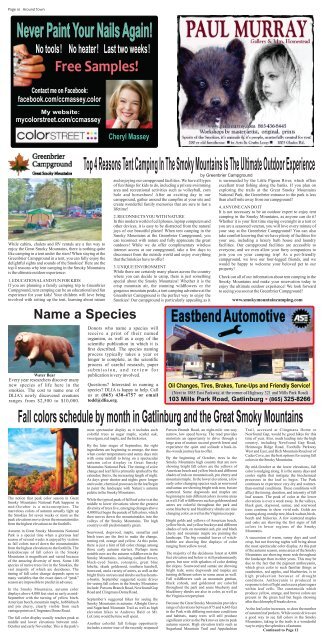Smoky Mountains Around Town / October 2018 Issue
What To See And Where To Be In The Smokies!
What To See And Where To Be In The Smokies!
You also want an ePaper? Increase the reach of your titles
YUMPU automatically turns print PDFs into web optimized ePapers that Google loves.
Page 10 <strong>Around</strong> <strong>Town</strong><br />
Never Paint Your Nails Again!<br />
No tools ! No heater ! Last two weeks !<br />
Free Samples!<br />
Contact me on Facebook:<br />
facebook.com/ccmassey.color<br />
My website:<br />
mycolorstreet.com/ccmassey<br />
Cheryl Massey<br />
While cabins, chalets and RV rentals are a fun way to<br />
enjoy the Great <strong>Smoky</strong> <strong>Mountains</strong>, there is nothing quite<br />
like camping in a tent under the stars! When staying at the<br />
Greenbrier Campground in a tent, you can fully enjoy the<br />
delightful sights and sounds of the Smokies! Here are the<br />
top 4 reasons why tent camping in the <strong>Smoky</strong> <strong>Mountains</strong><br />
is the ultimate outdoor experience:<br />
1. EDUCATIONAL AND FUN FOR KIDS<br />
If you are planning a family camping trip to Greenbrier<br />
Campground, tent camping can be an educational and fun<br />
experience for your kids! Your children will love being<br />
involved with setting up the tent, learning about nature<br />
Top 4 Reasons Tent Camping In The <strong>Smoky</strong> <strong>Mountains</strong> Is The Ultimate Outdoor Experience<br />
by Greenbrier Campground<br />
Name a Species<br />
Water Bear<br />
Every year researchers discover many<br />
new species of life here in the<br />
smokies. The cost to name one of<br />
DLIA’s newly discovered creatures<br />
ranges from $2,500 to $10,000.<br />
and enjoying our campground facilities. We have all types<br />
of fun things for kids to do, including a private swimming<br />
area and recreational activities such as volleyball, corn<br />
hole and horseshoes! After an exciting day in our<br />
campground, gather around the campfire at your site and<br />
create wonderful family memories that are sure to last a<br />
lifetime!<br />
2. RECONNECTS YOU WITH NATURE<br />
In this modern world of cell phones, laptop computers and<br />
other devices, it is easy to be distracted from the natural<br />
joys of our beautiful planet! When tent camping in the<br />
<strong>Smoky</strong> <strong>Mountains</strong> at the Greenbrier Campground, you<br />
can reconnect with nature and fully appreciate the great<br />
outdoors! While we do offer complimentary wireless<br />
internet access at our campground, take a few days to<br />
disconnect from the outside world and enjoy everything<br />
that the Smokies have to offer!<br />
3. UNIQUE ENVIRONMENT<br />
While there are certainly many places across the country<br />
where you can decide to camp, there is just something<br />
special about the <strong>Smoky</strong> <strong>Mountains</strong>! Whether it is the<br />
crisp mountain air, the stunning wildflowers or the<br />
gorgeous mountain peaks, a tent camping adventure at the<br />
Greenbrier Campground is the perfect way to enjoy the<br />
Smokies! Our campground is particularly appealing as it<br />
Donors who name a species will<br />
receive a print of their named<br />
organism, as well as a copy of the<br />
scientific publication in which it is<br />
first described. The species naming<br />
process typically takes a year or<br />
longer to complete, as the scientific<br />
process of careful research, paper<br />
s u b m i s s i o n , a n d r e v i e w f o r<br />
publication is very involved.<br />
Questions? Interested in naming a<br />
species? DLIA is happy to help. Call<br />
us at (865) 430-4757 or email<br />
todd@dlia.org.<br />
is surrounded by the Little Pigeon River, which offers<br />
excellent trout fishing along the banks. If you plan on<br />
exploring the trails at the Great <strong>Smoky</strong> <strong>Mountains</strong><br />
National Park, the Greenbrier entrance to the park is less<br />
than a half mile away from our campground!<br />
4. ANYONE CAN DO IT<br />
It is not necessary to be an outdoor expert to enjoy tent<br />
camping in the <strong>Smoky</strong> <strong>Mountains</strong>, as anyone can do it!<br />
Whether it is your first time staying overnight in a tent or<br />
you are a seasoned veteran, you will love every minute of<br />
your stay at the Greenbrier Campground! You can also<br />
take comfort knowing that we have plenty of facilities for<br />
your use, including a luxury bath house and laundry<br />
facilities. Our campground facilities are accessible to<br />
everyone, and we even allow your furry companions to<br />
join you on your camping trip! As a pet-friendly<br />
campground, we love our four-legged friends, and we<br />
would be happy to welcome your beloved pet to our<br />
property!<br />
Check out all of our information about tent camping in the<br />
<strong>Smoky</strong> <strong>Mountains</strong> and make your reservation today to<br />
enjoy the ultimate outdoor experience! We look forward<br />
to seeing you soon at the Greenbrier Campground!<br />
www.smokymountaincamping.com<br />
Eastbend Automotive<br />
Oil Changes, Tires, Brakes, Tune-Ups and Friendly Service!<br />
(Next to 1885 East Parkway, at the corner of Highway 321 and Mills Park Road)<br />
103 Mills Park Road, Gatlinburg • (865) 325-8266<br />
Fall colors schedule by month in Gatlinburg and the Great <strong>Smoky</strong> <strong>Mountains</strong><br />
The notion that peak color season in Great<br />
<strong>Smoky</strong> <strong>Mountains</strong> National Park happens in<br />
mid-<strong>October</strong> is a misconception. The<br />
marvelous colors of autumn actually light up<br />
the Smokies for seven weeks or more as the<br />
peak elevations move down the mountainsides<br />
from the highest elevations to the foothills.<br />
Autumn in Great <strong>Smoky</strong> <strong>Mountains</strong> National<br />
Park is a special time when a glorious leaf<br />
season of several weeks is enjoyed by visitors<br />
as fall colors travel down the mountainsides<br />
from the highest elevations to the foothills. The<br />
kaleidoscope of fall colors in the <strong>Smoky</strong><br />
<strong>Mountains</strong> is magnificent and varied because<br />
of the amazing diversity of trees. Some 100<br />
species of native trees live in the Smokies, the<br />
vast majority of which are deciduous. The<br />
timing of fall color change depends upon so<br />
many variables that the exact dates of “peak”<br />
season are impossible to predict in advance.<br />
In the <strong>Smoky</strong> <strong>Mountains</strong>, autumn color<br />
displays above 4,000 feet start as early as mid-<br />
September with the turning of yellow birch,<br />
American beech, mountain maple, hobblebush<br />
and pin cherry, clearly visible from such<br />
vantage points as Clingmans Dome Road.<br />
The fall color display usually reaches peak at<br />
middle and lower elevations between mid-<br />
<strong>October</strong> and early November. This is the park’s<br />
most spectacular display as it includes such<br />
colorful trees as sugar maple, scarlet oak,<br />
sweetgum, red maple, and the hickories.<br />
By the later stages of September, the right<br />
ingredients are beginning to emerge, the time<br />
when cooler temperatures and sunny days mix<br />
with some rainfall to bring on a spectacular<br />
autumn color display in Great <strong>Smoky</strong><br />
<strong>Mountains</strong> National Park. The timing of color<br />
change and leaf fall is primarily sparked by the<br />
calendar; that is, the increasing length of night.<br />
As days grow shorter and nights grow longer<br />
and cooler, chemical processes in the leaf begin<br />
to paint the landscape with Nature’s autumn<br />
palette in the <strong>Smoky</strong> <strong>Mountains</strong>.<br />
While the typical peak of fall leaf color is at the<br />
middle to lower elevations where the greatest<br />
diversity of trees live, emerging changes above<br />
4,000 feet begin the parade of fall colors, which<br />
then moves down the mountainsides into the<br />
valleys of the <strong>Smoky</strong> <strong>Mountains</strong>. The high<br />
country is still predominantly green.<br />
Sourwood, dogwood, maple, sassafras and<br />
birch trees are the first to make the change,<br />
turning red, orange and yellow. At this point,<br />
there is just a hint of fall color change among<br />
those early autumn starters. Perhaps more<br />
notable now are the autumn wildflowers in the<br />
<strong>Smoky</strong> <strong>Mountains</strong>, including cardinal flower,<br />
black-eyed Susan, coreopsis, great blue<br />
lobelia, skunk goldenrod, southern harebell,<br />
ironweed, and a variety of asters, as well as the<br />
bright fruits on trees and shrubs such as heartsa-bustin.<br />
September suggested scenic drives<br />
for seeing fall colors in the <strong>Smoky</strong> <strong>Mountains</strong><br />
include: Parsons Branch Road, Newfound Gap<br />
Road and Clingmans Dome Road.<br />
September’s suggested hikes for seeing the<br />
<strong>Smoky</strong> <strong>Mountains</strong> in autumn: Albright Grove<br />
and Sugarland Mountain Trail as well as high<br />
elevation hikes to Andrews Bald or Mt.<br />
LeConte would be time well spent.<br />
Another colorful fall foliage opportunity<br />
includes a motor tour of the recently reopened<br />
Parson Branch Road, an eight-mile one-way<br />
narrow, low speed byway. The road provides<br />
motorists an opportunity to drive through a<br />
large area of mature second growth forest and<br />
experience the quiet and solitude a back-inthe-woods<br />
journey has to offer.<br />
By the beginning of <strong>October</strong>, trees in the<br />
<strong>Smoky</strong> <strong>Mountains</strong> high country that are now<br />
showing bright fall colors are the yellows of<br />
American beech and yellow birch and different<br />
shades of reds on mountain ash, pin cherry and<br />
mountain maple. In the lower elevations, a few<br />
early color changing species such as sourwood<br />
and sumac are showing bright reds now, but are<br />
scattered. Some dogwoods and maples are<br />
beginning to turn different colors in some areas<br />
as well. Fall wildflowers such as goldenrod and<br />
asters are colorful throughout the park and<br />
some blueberry and blackberry shrubs are also<br />
changing color, as well as the Virginia creeper.<br />
Bright golds and yellows of American beech,<br />
yellow birch, and yellow buckeye and different<br />
shades of reds on mountain ash, pin and black<br />
cherry and mountain maple are painting the<br />
landscape. The big rounded leaves of witchhobble<br />
are showing fine displays of color<br />
ranging from yellow to red.<br />
The majority of the deciduous forest at 4,000<br />
feet elevation and below is still predominantly<br />
green, but now with splashes of color dotting<br />
the slopes. Sourwood and sumac are showing<br />
bright reds; some dogwoods and maples are<br />
turning different colors in some areas as well.<br />
Fall wildflowers such as mountain gentian,<br />
black cohosh, and goldenrod are colorful<br />
throughout the park and some blueberry and<br />
blackberry shrubs are also in color, as well as<br />
the Virginia creeper plant.<br />
Because the Great <strong>Smoky</strong> <strong>Mountains</strong> provide a<br />
range of elevations between 875 and 6,643 feet<br />
in the Park with differing moisture conditions<br />
and habitats, many trees will still produce<br />
significant color as the Park moves into its peak<br />
autumn season. High elevation trails such as<br />
Sugarland Mountain Trail and Appalachian<br />
Trail, accessed at Clingmans Dome or<br />
Newfound Gap, would be good hikes for this<br />
time of year. Also, roads leading into the high<br />
country, including Newfound Gap Road,<br />
Heintooga Ridge Road, Foothills Parkway<br />
West and East, and Rich Mountain Road out of<br />
Cades Cove, are the best options for seeing fall<br />
colors in the <strong>Smoky</strong> <strong>Mountains</strong>.<br />
By mid-<strong>October</strong> at the lower elevations, fall<br />
color is nudging along. It is the sunny days and<br />
cooler nights that instigate the biochemical<br />
processes in the leaf to begin. The Park<br />
continues to experience very dry and warmerthan-normal<br />
conditions. These conditions will<br />
affect the timing, duration, and intensity of fall<br />
leaf season. The peak of color at the lower<br />
elevations is over a week away. In the valleys,<br />
black gum, dogwood, sumac, and sourwood<br />
trees continue to show vivid reds. Golds are<br />
coming along on tulip tree, black walnut, birch,<br />
beech and hickories. A few scattered maples<br />
and oaks are showing the first signs of fall<br />
colors in lower regions of the <strong>Smoky</strong><br />
<strong>Mountains</strong>.<br />
A succession of warm, sunny days and cool<br />
crisp, but not freezing nights will bring about<br />
the most spectacular color display. At this part<br />
of the autumn season, some areas of the <strong>Smoky</strong><br />
<strong>Mountains</strong> are showing more reds throughout<br />
the landscape than in other years. This may be<br />
due to the fact that the pigment anthocyanin,<br />
which gives color to such familiar things as<br />
cranberries, red apples, and blueberries, is in<br />
high production because of drought<br />
conditions. Anthocyanin is produced in<br />
response to lots of light and excess plant sugars<br />
within leaf cells. The carotenoids which<br />
produce yellow, orange, and brown colors are<br />
present in the green leaf but begin showing<br />
after the chlorophyll breaks down.<br />
As the leaf color increases, so does the number<br />
of autumn leaf peekers. While scenic drives are<br />
a good way to see fall colors in the <strong>Smoky</strong><br />
<strong>Mountains</strong>, taking to the trails is a wonderful<br />
way to enjoy the splendors of autumn.<br />
Continued to Page 12















